NGC Ancients: Circulating Roman Coinage of A.D. 12: A Look Back
Posted on 1/22/2012
Two thousand years ago, the world bore little resemblance to the one we know today. In A.D. 12, the superpowers were not the United States or China, but Rome and Parthia. Greek political dominance of the Mediterranean had long since given way to the conquering Romans, though Hellenistic culture itself would continue to hold sway in the region for millennia to come.
Similarly, the Roman Republic was a thing of the past by A.D. 12, superseded by the Roman Empire, which had been founded by Augustus (27 B.C.-A.D. 14) almost forty years before. The first Roman Emperor was destined to reign two more years, but the empire he brought into being would live on for more than four centuries after his death.
The coinage of Rome in A.D. 12 had mostly assumed a form that would last, with some modifications, for roughly the next three hundred years. The basic silver unit was the denarius, equal to four brass sestertii.

This example would have been one of the more common denarii types encountered in commerce two thousand years ago. It features on the obverse a stern portrait of Augustus, who would have been between sixty and seventy-five years of age at the time this coin was struck. The reverse shows a depiction of Gaius and Lucius Caesars, two grandsons and adopted heirs of Augustus who would die before having the opportunity to assume power; that honor eventually fell to Tiberius, who succeeded Augustus upon his death in A.D. 14.
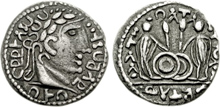
It is interesting to note that this denarius type was so prominent that it was still counterfeited by Germanic tribes for many decades (and possibly even centuries) to come. This coin is a crude but instantly recognizable copy of the original illustrated above, and was possibly produced as late as the third century A.D., more than two hundred years after the original issuer of the coin had died. Ironically, three years before the year 12, one of Augustus’s generals, P. Quinctilius Varus, had lost three legions to an ambush in Germany, a catastrophic event that brought Roman expansion in the north to a sudden halt.
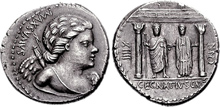
In addition to the imperial denarii of Augustus, many Republican denarii would still have been circulating as well. Those coins were reminders of a time that was only forty years in the past. This denarius, a particularly fine example, issued under the authority of the moneyer Cn. Egnatius Cn.f. Cn.n. Maxsumus in 76 B.C., depicts Cupid on the obverse and on the reverse a temple with Jupiter and Libertas standing within.
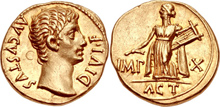
Though far less common than the silver denarius, this gold aureus of Augustus may have been encountered by a merchant in the year 12, as evidenced by the banker’s mark behind the head of Augustus on the obverse. The reverse commemorates the Battle of Actium (31 B.C.), in which Augustus and his longtime general, Agrippa, defeated the combined forces of Marc Antony and Cleopatra VII. This monumental event effectively marked the end of the Roman Republic and paved the way for the foundation of the Empire under Augustus
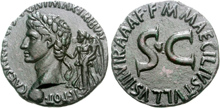
Far more common were the bronze denominations: the as, dupondius, and sestertius. This coin, which would have been about twenty years old in A.D. 12, is classified as either an as or a dupondius. Unlike issues under later emperors, where the dupondius denomination is indicated by a radiate crown on the bust, the difference between the “as” and “dupondius” under Augustus is often unclear. This coin, struck under the authority of the moneyer M. Maecilius Tullus, depicts a bust of Augustus with the figure of Victory behind his head. The reverse features an inscription surrounding the letters “SC,” signifying that the Roman Senate had (nominally, at least) authorized this particular issue. The coin may commemorate the military victories of Tiberius in Germania around the year 7 B.C., but this is open to scholarly interpretation at present.
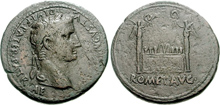
This sestertius, which was minted A.D. 10-14, is another example of circulating Roman imperial coinage of two thousand years ago. The obverse features a portrait of Augustus, and the reverse depicts the Great Altar of Lugdunum, the city where the coin itself was minted. The altar was the site of worship for a cult devoted to Rome and Augustus.
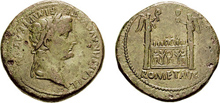
Interestingly, this rare sestertius, which was probably struck between A.D. 12 and 14, illustrates an empire on the verge of transition. Though the reverse type is the same as the issue of Augustus illustrated above, this coin features a portrait of Tiberius on the obverse. Tiberius, one of the adopted heirs of Augustus, was still two years away from becoming the second Roman Emperor, but in the year 12 was already being groomed for power in the subordinate position of Caesar.
The coinage that would have circulated throughout the Roman Empire in the year A.D. 12 provides a record of a civilization that has long since passed into the history books. It reflects a very interesting time in the overall chronology of the Romans: the later years of the Republic would have been a not-so-distant memory to many citizens, but the Empire was becoming firmly established and destined to endure for centuries to come.
Images courtesy of Classical Numismatic Group.
Stay Informed
Want news like this delivered to your inbox once a month? Subscribe to the free NGC eNewsletter today!
